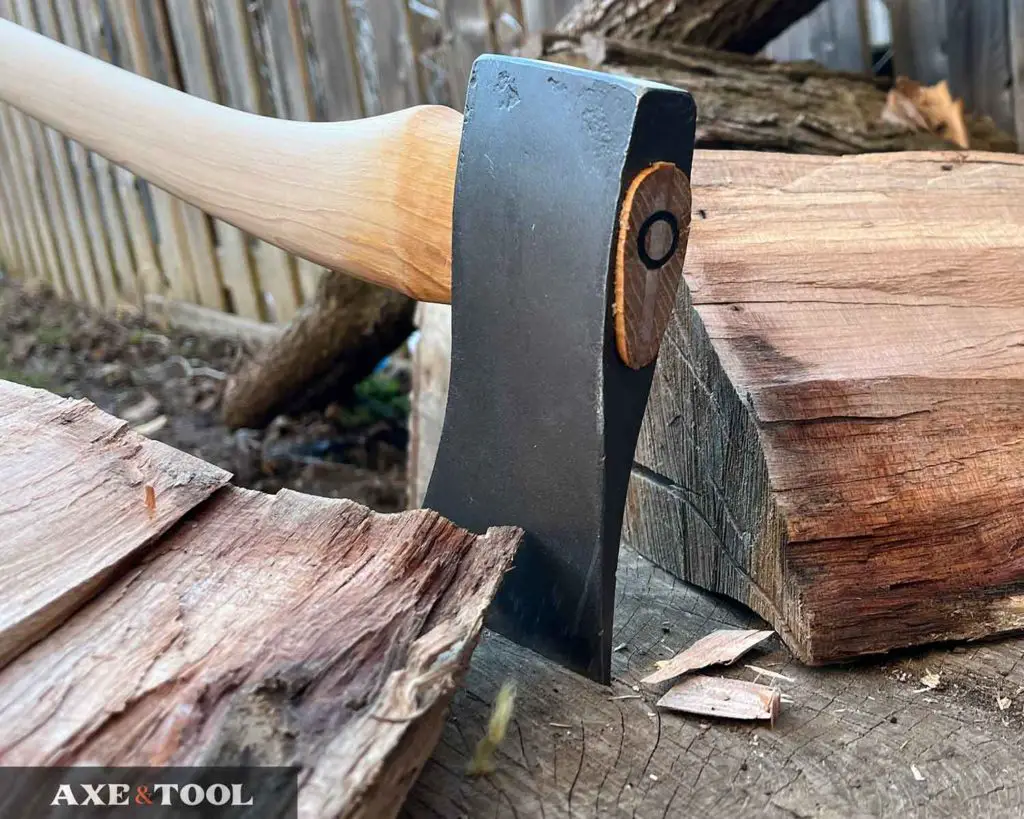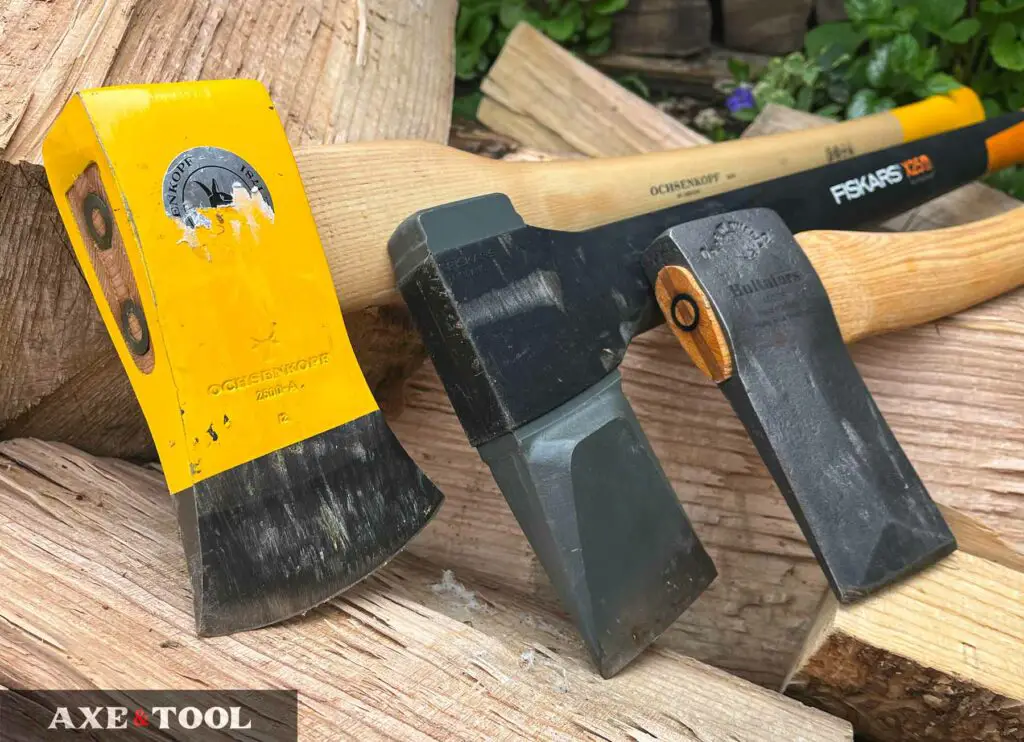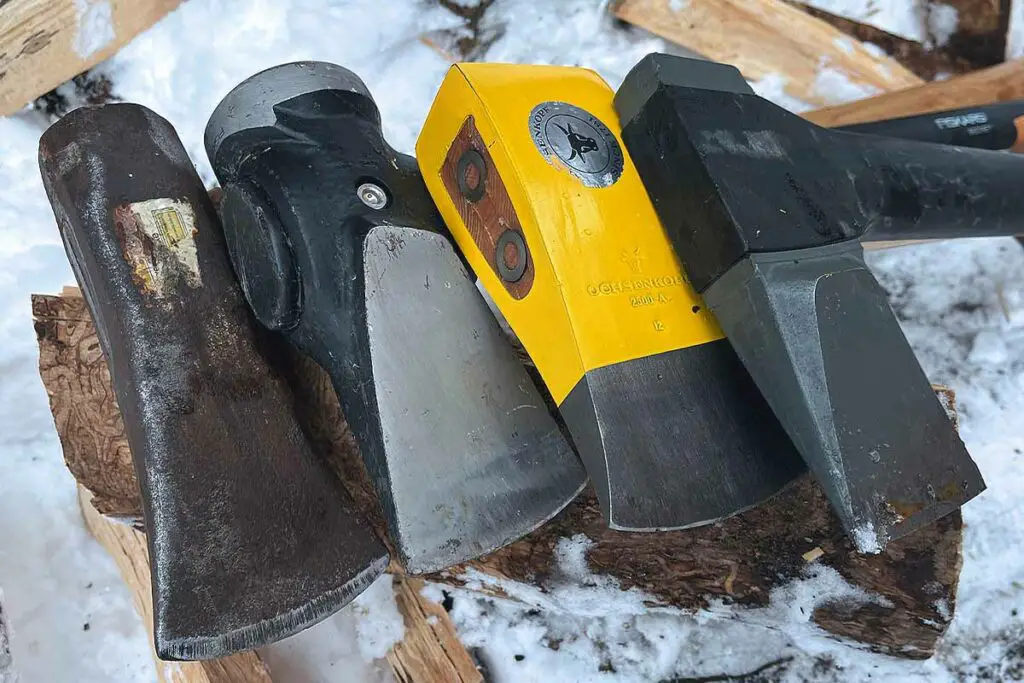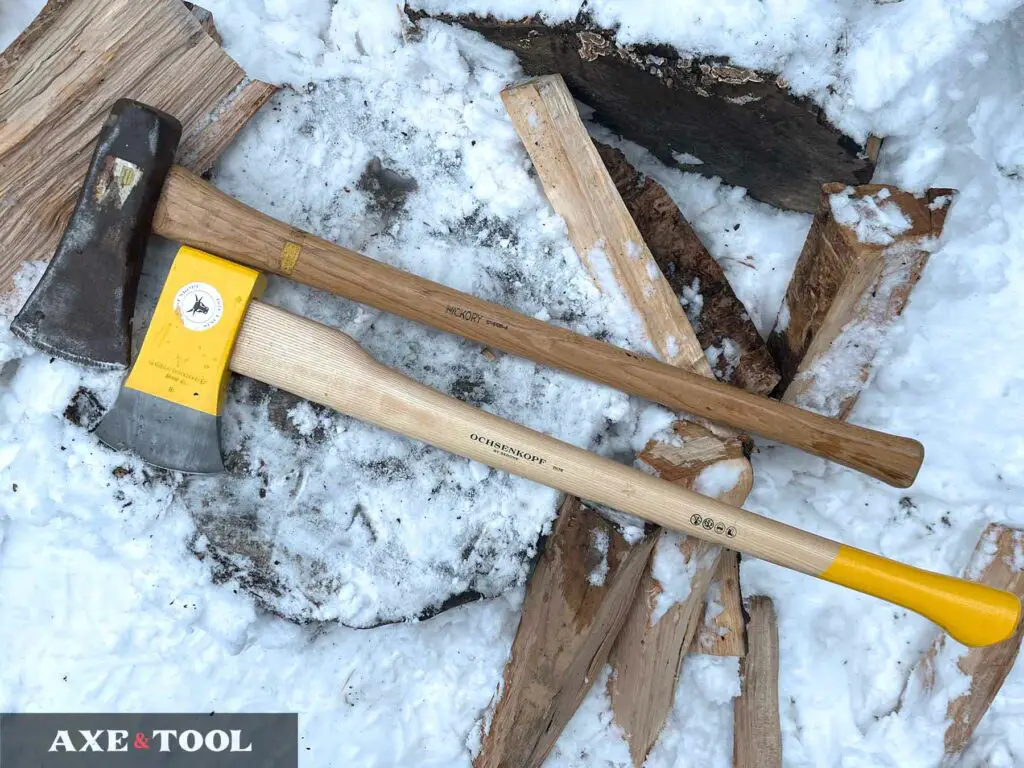What Makes An Axe Good For Splitting Wood (Sizes and Shapes)

Most axes are capable of splitting wood, but some are going to be much better than others.
An axe with a short blade, wide wedge-shaped profile, and heavier head will be best for splitting wood apart, and splitting axes combine all these features. However, mauls and felling axes also have their uses for splitting.
Different types of axes used for splitting wood
There are three main types of axes: Felling axes, Splitting axes, and Mauls.

Can a felling axe split wood?
Felling axes are primarily designed for felling (chopping down) trees and chopping wood. They are usually capable of medium-to-light splitting but are more likely to get stuck and require more swings.
Felling axes tend to have narrow blades to chop deep into the side of the tree, which isn’t as efficient for splitting – since you have to drive in deeper before you force the wood apart.
But some patterns have a wider – more wedge-shaped design that can split pretty well. Older felling axes from North America often have wide rounded cheeks that make them quite good for splitting.
Spitting axes are best for splitting wood

Full-size splitting axes have wider, heavier heads that range from 4-6 lbs. They are designed specifically to spread the grain of the wood being split quickly and fling them apart. They typically also have straight handles which is more consistent for splitting.
Unlike the felling axe that can do a mix of tasks, splitting axes can only be used for splitting. But they are also much more effective at it than felling axes.
If you are doing a lot of splitting these axes should be your primary splitting tool – especially with large trees.
Splitting Mauls are for the toughest logs

Not everyone realizes that mauls and splitting axes aren’t the same tools.
Mauls are bigger and heavier than splitting axes. They have a 6-8lbs head, and the back of a maul is hardened like a sledgehammer. So it can also be used to hammer splitting wedges.
I typically only use mauls as needed, as they are overkill for a lot of smaller pieces. But it can be handy to have a maul as a backup to a splitting axe for when things get tough.
Especially, if you have larger rounds that were left to season (dry and harden) instead of splitting them green (which you should try to do).
While Mauls are designed to hammer wedges, you should not hammer on other mauls. The hardened metal is more likely to chip and send sharp metal bits flying. Wedges are deliberately made softer.
Check out ‘Splitting Axes vs Mauls‘ if you still want to know more.
A heavier axe is better for splitting wood.
A heavy axe will deliver more force and will be better at splitting larger wood in fewer strokes. However, if an axe is too heavy it can be less efficient. Additionally, shape and sharpness also impact how well an axe can split wood.
I usually recommend around a 4-5lb head, as this weight is large enough to split larger 24″+ rounds, but also small and light enough to swing accurately and for long periods.
It might take a few more swings for the larger pieces, but it will be more efficient overall compared to the big 8lbs options.
Axe weight to log size
This chart is subjective and can be impacted by axe type, wood type, and user experience. But, it’s at least a rough starting point.
| Head Weight | Log Size |
|---|---|
| 6 – 8lb | 16″+ |
| 4.5 – 6lbs | 12-24″ |
| 3 – 4lbs | 8-16″ |
| 1.5 – 2.5lbs | 6-10″ |
Too heavy an axe can be less efficient for splitting wood
A very heavy axe or maul (6-8 pounds) will be the best to split through the largest toughest rounds, without question. But you don’t need that much weight and power most of the time.

As you split your rounds, the majority of the swings you are going to make are going to be at progressively smaller pieces of wood. Pieces that don’t need a really heavy axe head to split them apart.
Using a 6-8 pound axe or maul will be a good workout – but you are more likely to tire out or injure yourself using it for a long time. Plus it’s just harder to be accurate with the heavy axes.
Should a splitting axe be sharp?
A splitting axe should be kept sharp. The blade edge needs to penetrate the wood to allow the axe to drive in and start splitting. A sharp edge is also useful for cutting through stringy and twisted wood fibers that can hold tough pieces together.
This is often overlooked with splitting axes. Many people assume that just because they are big and heavy that sharpness doesn’t matter.
Splitting axes don’t need to be “shaving sharp”, but they should be sharp.
What is the best shape of a splitting axe?
Weight and sharpness alone won’t make an axe good for splitting. The most important factor is going to be the shape of the head.
The best shape for a splitting axe is shorter and wider, forcing the wood to spread quickly. This is typically found in a wedge or flared cheek design. The cutting edge should also be narrow with
In splitting it’s the sides of the axe, spreading the grain apart that does the majority of the work. The cutting edge is needed to create an opening, but the cheeks (sides) of the axe are what push the wood apart.

Narrow axe blades take more effort
A long narrow blade won’t start to spread the wood very far apart until it hits the eye. And the blade will be under a lot more friction all the way through. This wastes a lot of energy before the splitting really starts, and can cause the axe to get stuck or pinched in the wood.
Many felling axes have these thinner blades, and they can still work for moderate splitting just fine. But they won’t be as efficient as a dedicated splitter – especially when you get up to logs that are 12″ plus.
Wedge-shaped axes are great for splitting
A wedge-shaped head will force the wood apart quickly, reducing the pressure/friction from the front of the bit, and increasing the chance of fully splitting the log. Shorter wedges are even more effective as they widen quickly spreading the wood sooner.
A wedge-like shape can often make a good general-purpose axe, capable of splitting, chopping, and felling. The wedge won’t chop as deep as some of the thinner heads, but it will bust out chips and splits much easier.
The wedge shape doesn’t always mean flat sides. Some axes only widen into a thick wedge in the middle of the cheeks, then thin out at the top and bottom of the blade. They can be diamond-shaped, or have rounded cheeks.

The extra width in the middle spreads the wood, and the rounded shape makes it easier to twist the blade to pry the wood apart or free your blade.
You have to be more accurate with these axes where they only get wide in the middle. The thin parts can get pinched if you don’t get enough of the blade width in the log.
Old American felling axes can make great splitting axes as they often have thick rounded cheeks and a shorter worn-out cutting edge.
Flared splitting axes are best for dedicated splitters
Axes with flared cheeks are designed specifically for splitting. And they improve on the advantages of the wedge. The flared cheeks act as ramps that fling the wood apart, and quickly remove any friction between the blade and the wood.
Some designs will be fully flared from top to bottom of the head, while others will only be partially flared to allow for more twisting and prying.

I really like the Fiskars splitting axe heads. They have nice wide flares, but a little bit of taper on the top and bottom, making them very effective. See my post on Fiskars Splitting Axes.
I don’t like axes with “German-style” or “Rhineland” splitting pattern, as I find they get stuck more. The ramps are really narrow, meaning you have to be much more precise.
These axes are basically useless for chopping and felling and are only meant for splitting wood apart.
A short flat cutting edge is more efficient for splitting
Most splitting axes have a shorter, flatter cutting edge. Axe heads with wide blades and deeper curved bits are more likely to get pinched in the wood as the edges thin out.
Best handles for splitting axes

Most splitting axes have straight handles. Straight handles are stronger and land the blade flatter when splitting. Curved handles allow for greater rotation, which is not something you want when splitting.
Of course, people split wood with curved handles all the time. They are totally usable.
Best handle material for splitting wood
Composite handles like on Fiskars splitting axes are lightweight, do a great job of reducing felt vibration, and most importantly – are strong. You don’t need to worry about overstrikes, and you can even use the handle to help pry stubborn wood apart.
Wood handles feel great in hand, and are naturally flex to absorb impact – but they have some drawbacks. An overstrike (where you hit the log with your handle) can crack or damage the handle. You add a “collar” and wrap under the head with a protective material like leather, or wire – but it’s not a sure thing.
Wood handles also require more care like oiling. But working with a tool with a properly maintained wood-handled tool just feels special.
I would avoid steel-handled axes for splitting large amounts of wood. Steel doesn’t flex or bend, so all the vibration and impact gets delivered back to you. These axes rely on padding to ease the blow, which makes the handles really thick, and less comfortable to hold.
Conclusion
Most axes can be used to split wood to some capacity – but for best results, you should consider buying a dedicated splitting axe.
Please comment below If I missed something or if you have any questions. I do my best to respond to everyone.
About the author:
About the author:
Jim Bell | Site Creator
I’m just a guy who likes axes. I got tired of only finding crap websites, so I set out to build a better one myself.
I’m also on Instagram: @axeandtool



All felling axes have thin blades. They are made for cutting across grain and as a result need to have a thin profile. They are great for splitting straight grained wood like (most) ash and alder, but not so with the bigger stuff. When blocks get big and have knots and/or twisted grain it is time for the splitting axe with a wider profile or the splitting maul which is heavier again. Each tool has its advantages and disadvantages and, of course, there are times when the axe and maul are not up to the job. Then you need the sledgehammer and wedges to break open the really tough stuff. I can only speak for myself but I would never use a maul as a sledge. Sledgehammers are relatively cheap and are made for striking, unlike mauls which sometimes can be fairly expensive.
Thanks for the comment – I think I need to re-work the article a bit because re-reading it I can see I’ve been vague in some areas, and missed some things.
A lot of felling axes have thin blades, but there are wider wedge patterns, and older axes with thick cheeks (like Michigans) that can make good splitters as well. Especially if they are a little worn down.
I will happily use my older mauls as a sledge, but agree it is much harder to stomach with some of the newer expensive ones – even though I am sure they can handle it.
Also the force from the axe is mass x velocity squared. So double the speed quadruple the force. Therefore a fast light axe is more effective than a slow heavy one….
Jim,
I just wanted to thank you for the exact type of information I’ve spent my entire day researching to no avail, until I found your article! I purchased a axe recently at a auction and to be completely honest was dumbfounded when I got home and attempted to get a little background on my new treasure and after a few hours on the internet I gave up. Today I decided to give it another whirl, argh. I am a 57 year old female who’s apparently got a lot to learn about the many many types of axe styles and usages but you were able to explain everything in a way that was informative in which I was able to grasp. Thank you!
Christine
I had a lot of frustration finding info when I was starting with axes, so it means a lot to hear it’s useful for people. And the more you learn, the more you realize you don’t know lol. Thanks for the great comment.
Good stuff that’s hard to find elsewhere – also appreciate your humility which allows you to take into consideration comments from informed readers. I prefer advice from humble people – character makes a difference.
Thanks for the great feedback – really appreciate it. I try not to sound like a know-it-all, because I certainly don’t.